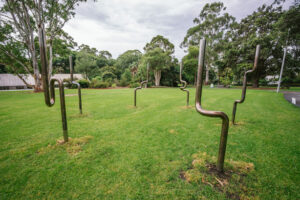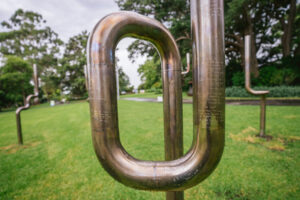Sculpting a unique garden experience
By Gabrielle Stannus
If you are a manager of a park or garden seeking to increase its visitation rates, have you considered installing artwork either permanently or temporarily to enhance visitor experience? I spoke with two people behind the scenes at this year’s Sculpture in the Garden exhibition at the Wollongong Botanic Garden in New South Wales, to find out their tips for ensuring public art looks ‘good’ and functions ‘well’ whilst enhancing the existing attributes of a landscape.
Over 40,000 people visited this year’s Sculpture in the Garden held at the Wollongong Botanic Garden – the fourth time that this biennial event has been held in this location. 23 sculptures from local and national artists were put on display from 18 March to 30 April in the natural surrounds of this regional botanic garden.

“Gardens are for people, so when people come through the gates, we want them to engage with this beautiful space and have a transformative experience with nature. To be able to add another layer of interest by the inclusion of art, especially a variety of art, brings a whole new audience to the Garden,” explains Felicity Skoberne, Curator of Wollongong Botanic Garden, of this exhibition.
The Wollongong Botanic Garden typically sees around 17,000 people during the month of April when no events are scheduled. During the six-week exhibition period, Wollongong City Council conducted a visitor survey and found that around 20% of the visitors had not been to the garden before.
“For us, a large part of the project is bringing fine art outside of galleries and museums, to make the art more accessible to community members who might not ordinarily engage with professional artists and professional art exhibitions in traditional settings. From a cultural development perspective, there is also the opportunity to engage communities through our exhibition-aligned, free public programs,” says Felicity.

The Sculpture in the Garden exhibition includes the $30,000 Wollongong Acquisitive Sculpture Award, and a People’s Choice Award. Local sculptor Deborah Redwood was the winner of this year’s acquisitive award for her piece Banksia, inspired by the plants named after the famous botanist, Sir Joseph Banks. “The banksia has this incredible fragrance, and I am always stopping to smell it. The beautiful thing is that there are so many species (of banksia); that gives the artist a bit of leeway artistically as well,” says Deborah, of representing this genus in sculptural form. Banksia’s subject matter also means it fits in well in the context of a botanic garden, showing that ‘good’ artwork responds to its environment.

Banksia was almost unanimously selected for the acquisitive award by the judging panel, a first according to council sources, who said that Deborah’s artwork was chosen for its strong botanic theme and playful scale. The judges also considered its theme and design, the public’s response to the artwork, and the quality of the work. The latter is a must as, being an acquisitive prize, the artwork must be robust and long lasting as it will be permanently installed in Wollongong Botanic Garden. Other sculptures were displayed only temporarily over the six-week exhibition period, including the joint winners of the People’s Choice award: Enlightened by Nature by Juliane Brandt, and Memorial for Black Summer by Danny Ivanovski.
Felicity says that when considering where to locate Banksia and other permanent sculptures in Wollongong Botanic Garden, placement is paramount: “We strategically locate the art along the system of pathways so that it is spread throughout the garden, curated to not impact upon the magnificent trees or garden beds, but to enhance vistas and create a sense of discovery for each work. You can walk along a path, turn a corner, and the art will be there to greet you. Or you may gaze along a ridgeline and see a work from afar, then work out how to navigate to it, all the while being immersed in the garden.

“Sculptures are located to complement existing gardens and specimen trees. Several of the works in this year’s exhibition featured the trees, using their trunks, with the trees becoming the focus of the piece! Other sculptures are located in open space contrasting against the green grass. The forms and textures of native grass and shrubs formed an amazing backdrop for some sculptures. Each position was carefully selected so that the works could be enjoyed individually.
“Sometimes the subject matter of public art can evoke strong emotions and can make a statement with intention to engage the audience. So, I think consideration of what the piece may engender is important. For example, I want our Botanic Garden to be a joyful relaxing retreat in the midst of our busy city, therefore, sculpture here should engender joy, reflection, or a sense of peace, to enhance their connection to the Garden.

“In relation to its visual impact, do you want to the sculpture to be the hero, or do you want the garden to be the hero, and the sculpture be a delightful addition that enhances the overall beauty of the space? This is an important consideration. Here we endeavour to enhance our garden, through careful placement we create a journey of discovery for the visitors, whereas, in other public open space, the designer may wish for the artwork to be the locus of the space.
“For both temporary and permanent installations, we propose the site considering the visual impact first, then consider if the placement will impact the adjacent surrounds. For example, we worked to ensure that footings are discreet and shallow, not within tree protection zones. We also undertake underground service location. Does the footing and structure need to be engineer certified? “Safety first always! The work may look beautiful, but all its edges must be smooth, no finger or head entrapment. Would kids automatically want to climb or sit on it? That is okay if it is considered in the design – including its placement within the landscape, but does it need a suitable surface around it?”
Locating a sculpture effectively is critical if you want to get the most from it visually, and, Felicity says, it is also very important from a maintenance perspective: “Gardeners must be able to navigate around the sculpture to maintain lawns and garden beds. Placement is key – consider a hardstand area, or locating the piece within a garden to make the maintenance of the sculpture and it surrounds easier.
“Sculpture also needs to be robust in its materiality, if it is intended to last in the landscape. The patina process, should be considered thoughtfully so that the sculpture ages gracefully. Reflective surfaces can create radiant heat and confuse wildlife. Understand the intended length of time the sculpture is needed in place, and make sure that you commission works that will meet the test of time, and are certified structurally sound above and below the ground.”
Whilst sculptor Deborah Redwood has worked with other media, she tends to select steel for its durability in all types of elements, as seen in her piece ‘Banksia’. “I have worked in stone, but you know, it is a bit hard on the hands and shoulders! There are two types of steel commonly used for outdoor sculptures. There is the ordinary mild steel and now there is the Corten steel. Corten rusts only once and then never rusts again; you do not really need to maintain it. However, if you put that type of steel near white concrete, then the rust can stain the finish of that surface. The maintenance of most other steel sculptures is simple. You just coat them with Penetrol once or twice a year, the same that you would do with a steel gate or fence. And that protects the work and lets it last pretty much forever.”
If the sculpture includes moving parts or water elements, make sure they can be accessed for maintenance. “Fountains tend to be a lot of mucking around,” says Deborah of a sculpture she installed recently with a water feature, “I had to be really careful that those elements in contact with water were made of copper, not steel which will rust eventually even if it is painted.”
Rolling stones gather no moss, but a sedentary sculpture can accumulate detritus which, if not regularly cleaned, may detract from the artist’s original design objective and the visitor’s viewing pleasure. “I was in Sydney recently and saw several sculptures, most likely purchased by the local council, which were rusting due to lack of maintenance. And I also saw several colourful pieces covered in cobwebs, dirt, and dust. If you are purchasing a sculpture, it is quite normal to ask the sculptor to recommend a maintenance schedule which includes washing and polishing. This depends a lot on the material,” says Deborah.
Budget is another important consideration when commissioning artwork, including sculptures, for a public landscape or garden. Large sculptures can be costly to produce and to transport to their final resting place. “I was talking to someone at a gallery recently who said that she had just sold a sculpture whose delivery costs were more than that of the sculpture itself,” says Deborah. She also says that if you want works of quality, then you must pay artists properly, including, but not limited to, those works exhibited as part of exhibitions. The sculptor is grateful for the Wollongong City Council’s ongoing support of public art, saying each artist participating in the Sculpture in the Garden exhibition receives payment, and not only the competition winners. You get what you pay for after all!
If you would like further inspiration as to how sculpture can enhance a public landscape, I encourage you to visit the Wollongong Botanic Garden. There you can view previous winners of the Wollongong Acquisitive Sculpture Award in situ. To see more of Deborah Redwood’s unique sculptural work, visit www.deborahredwood.com.
Gabrielle Stannus
Inwardout Studio
M: 0400 431 277
E: gabrielle@inwardoutstudio.com
Main photo: Memorial for Black Summer detail (Image: Wollongong City Council)

